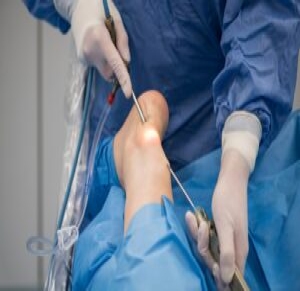Recovering At Home from Achilles tendon surgery can be a challenging, and frustrating period. It’s important to take care of yourself and be mindful of your limitations.
About Your Recovery
Achilles tendon repair reconnects the ends of the broken tendon so that you can use your foot again in a normal way. You may have had one of two types of surgery. In open surgery, a surgeon makes an incision at the back of your leg. In percutaneous (say “per-kyoo-TAY-nee-us”) surgery, the surgeon utilizes several smaller cuts. Tools for fixing the tendon are inserted through the cuts.
After surgery, you will feel tired for several days. Your lower leg and ankle will be swollen. You may have numbness around the cut (incision) on the back of your leg and your ankle and shin may be bruised.
Over time your tendon will slowly get stronger as you recover. You may need to wear a cast or a walking boot for 6 to 12 weeks after surgery. At first, it may be set to keep your foot pointed downward as the tendon heals. You may be able to put weight on your affected leg after a few weeks. But it will be several months before you have complete use of your leg and ankle. You will need to build your strength through rehabilitation exercises.
How soon you can return to sports or other exercise depends on how well you follow your rehab program and how well your tendon heals. Your physiotherapist will give you an idea of when you can return to your activities.
How can you care for yourself at home?
Activity
- Rest when you feel tired. Getting enough sleep will help you recover. Keep your leg raised (such as on a pillow) as much as possible for the first few days.
- You will need to wear a cast or walking boot that keeps your foot and ankle from moving for 6 to 12 weeks after surgery.
- You can use crutches to move around the house to do daily tasks. Do not put weight on your leg without these until your doctor says it is okay.
- You may shower 24 to 48 hours after surgery, if your surgeon okays it. When you shower, keep your bandage and incision dry by taping a sheet of plastic to cover them.
- If your surgeon does not want you to shower or remove your brace, you can take a sponge bath.
- Do not take a bath, swim, use a hot tub, or soak your leg until your doctor says it is okay.
- You can drive when you can move and control your foot and ankle, you are no longer using crutches, and you are no longer taking prescription pain medicine. This usually takes 4 to 6 weeks.
- How soon you can return to your work depends on your job. If you sit at work, you may be able to go back in 1 to 2 weeks. But if you are on your feet at work, it may take 6 to 8 weeks. If you are very physically active in your job, it may take 3 to 6 months.
Diet
- You can eat your normal diet. If your stomach is upset, try bland, low-fat foods like plain rice, broiled chicken, toast, and yogurt. Drink plenty of fluids.
- You may notice that your bowel movements are not regular right after your surgery. This is common. You may want to take a fibre supplement every day. If you have not had a bowel movement after a couple of days, ask your doctor about taking a mild laxative.
Medicines
- Your surgeon will tell you if and when you can restart your medicines.
- Take pain medicines exactly as directed.
- If your surgeon provides a prescription medicine for pain, take it as prescribed.
- If you are not taking a prescription pain medicine, you can take an over-the-counter medicine.
- If you’re prescribed antibiotics, take them as directed. Do not stop taking them just because you feel better. You need to take the full course of antibiotics.
- If you think your pain medicine is making you sick to your stomach:
- Take your medicine after meals (unless your doctor has told you not to).
Incision care
- If you have a bandage over your incision, keep the bandage clean and dry.
- If you have strips of tape on the incision, leave the tape on for a week or until it falls off. Keep the area clean and dry.
- If you have a splint or cast, keep it dry. Do not put anything, including powder, between the splint or cast and your skin.
Exercise
- Exercise in a rehab program is an important part of your treatment. Your first exercises will help you regain flexibility. They may also keep scar tissue from forming around the tendon.
Ice and elevation
- To reduce swelling and pain, put ice or a cold pack on your leg for 10 to 20 minutes at a time. Do this every few hours. Put a thin cloth between the ice and your skin.
- Prop up the sore leg on a pillow when you ice it or anytime you sit or lie down for 3 days after surgery. Try to keep it above the level of your heart. This will help reduce swelling.
Dr. Bagwe is a leading orthopedic surgeon specializing in ankle and foot reconstruction. If you are looking for an orthopedic surgeon near you then look no further. Dr. Bagwe is an industry leader when it comes to foot and ankle surgery doctors in St. Louis. Dr. Bagwe and his friendly and professional team is ready to welcome you and tell you everything you need to know.
Reach out and contact us today.






